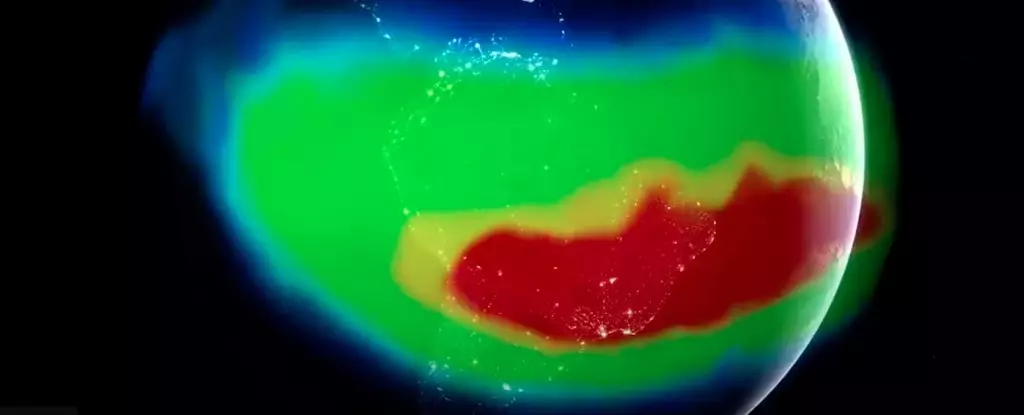Deep in the heavens above our planet lies a perplexing phenomenon known as the South Atlantic Anomaly (SAA). Stretching between South America and southwestern Africa, this extensive region exhibits a significant dip in Earth’s magnetic field strength. NASA, well aware of both the scientific intrigue and potential hazards posed by this anomaly, has designated it as a focus of ongoing research. The consequences of the SAA are not merely academic; its influence extends to the very technology we rely upon, particularly in space.
The SAA serves as a demonstration of Earth’s complex magnetic dynamics, which are critical for our understanding of numerous geological and physical processes. Scientists describe the phenomenon as akin to a “dent” or a “pothole in space,” where a diminished magnetic field exposes satellites and spacecraft to increased levels of harmful solar radiation. While the SAA does not appear to affect life on Earth directly, the risks it poses to technology in orbit warrant serious consideration.
Magnetic Menace: The Risks to Spacecraft
For the satellites and spacecraft that traverse low Earth orbit, entering the South Atlantic Anomaly can be a perilous endeavor. Within the anomaly’s weakened magnetic field, high-energy protons emitted from the Sun can rain down on delicate electronic systems. While many such encounters may result in minor glitches—annoying but not catastrophic—there is always the looming risk of severe data loss or irreversible damage to crucial hardware.
To mitigate these risks, satellite operators take preventative measures, such as shutting down specific systems before their craft enters the anomaly. This defensive approach reflects not only preparedness but also the apprehension surrounding the SAA’s unpredictable nature. As NASA continues to track this anomaly, researchers glean valuable insights that could lead to advancements in protecting technology from similar cosmic phenomena.
Understanding the Origins of the Anomaly
Understanding the SAA requires delving deep into the Earth’s inner workings. Much of our magnetic field originates from movements within the molten iron of our planet’s outer core, thousands of kilometers beneath the surface. These currents generate the magnetic field, yet, due to the non-uniform motion of the molten iron, certain areas are affected more drastically than others.
The presence of geological structures, such as the African Large Low Shear Velocity Province, has been identified as a factor disrupting the uniformity of this magnetic generation. These undergound structures may inhibit the currently dominant dipole magnetic field, allowing localized regions with reversed polarity to grow in significance, leading to the reduced intensity observed in the SAA.
Research conducted by NASA has helped clarify these relationships, with geophysicist Terry Sabaka noting that changes in the Earth’s magnetic field are driven by complex interactions within its core. As scientists investigate this interplay, new models are developed, enriching our understanding of Earth’s magnetosphere.
The SAA’s Changing Landscape
Fascinatingly, the South Atlantic Anomaly is not static; it’s characterized by movement and transformation. As part of ongoing research led by scientists such as NASA heliophysicist Ashley Greeley, the realization has emerged that the SAA is drifting over time. Moreover, recent tracking studies suggest that the anomaly is on the brink of dividing into two separate cells, each indicating a distinct center of minimum magnetic intensity.
This proposed segmentation raises monumental questions about the potential future of the SAA. If it continues to evolve in this way, what will the implications be for technological operations in orbit? Will new cells introduce further complications, or can we learn to adapt to these changes? The dynamic nature of the SAA indicates that it is a recurring and possibly long-standing feature of Earth’s magnetic behavior—one that could trace its history back millions of years.
With all the uncertainty surrounding the South Atlantic Anomaly, one thing is clear: it is a remarkable subject for scientific inquiry. The active monitoring and research efforts by NASA and other institutions underscore the importance of understanding this phenomenon in greater detail. Scientists recognize the need for sustained observation, not just to protect our technological assets but also to decode the complex geological processes at play.
The SAA may challenge our assumptions about Earth’s magnetic field, and as we continue to unveil its mysteries, we may very well discover insights that change our perspective on planetary magnetism itself. Intrigued by this “pothole in space,” researchers remain vigilant, eager to explore what its evolution might reveal about the depths of our planet and the cosmic environment that envelops us.

